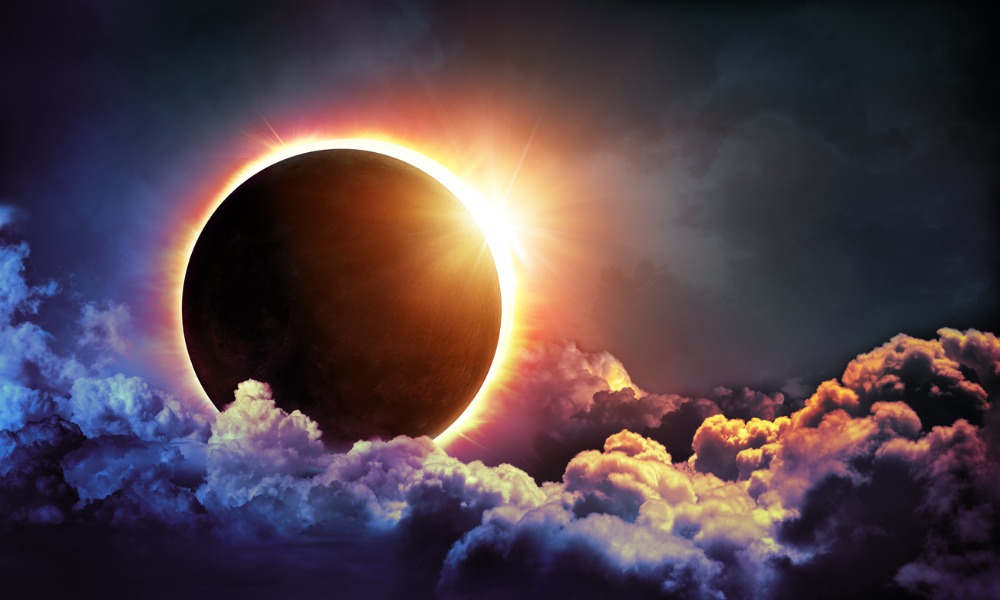Employers must protect workers from potential eye damage during event, says IHSA

On April 8, a solar eclipse will take place. The Moon will come between the Earth and the Sun and cast a shadow on Earth.
The short time it will take place could be a danger to workers’ eyes, and employers are buckling down to ensure their safety.
The Ontario General Contractors Association Safety Advisory Committee (OGCA) has released a bulletin to ensure worker safety during the event, according to a report.
“The ICI construction industry is prepared for this solar event and has communicated the potential hazards as well as how to avoid said hazards to their workers in advance of the event,” said Giovanni Cautillo, OGCA president, according to the report from Daily Commercial News.
“It is not seen as an overly serious event since the duration is from one to five minutes, but it is recognized as one that has the potential to cause harm to eyesight as well as the potential for distraction, especially for linear road work.”
Most members of the committee had drawn up a policy and planned toolbox talks. The committee also said that employers performing linear roadwork should have their workers take a break and remove themselves from roadwork for that period since drivers might be distracted, said Cautillo.
Drivers may even think it’s a good idea to videotape the event, even if driving, and that could increase the hazard, according to committee members.
“The potential for distraction is high,” said Cautillo in the report.
“Let’s hope that this solar eclipse does not harm any workers anywhere.”
What are the safety precautions for solar eclipse?
The Infrastructure Health & Safety Association (IHSA) noted that since this year’s total solar eclipse will take place during the normal workday, “employers have a duty to inform workers who work outside about the risks of looking at the eclipse”.
To protect workers, employers can do the following, according to IHSA:
- Deliver a safety talk to inform workers of the health risks that come with looking at the sun, including during an eclipse.
- Complete a hazard analysis that accounts for the change in conditions and tasks being completed during the eclipse. Review the analysis with workers.
- A total eclipse creates temporary darkness. Ensure the jobsite is adequately lit and that workers wear high-visibility clothing.
- Inform workers of safe ways to view the eclipse, emphasizing the importance of using approved eye protection, not makeshift filters.
- Set up a designated eclipse-viewing area—with proper equipment such as ISO-approved solar viewers or pinhole cameras—where interested workers can observe the event safely.
- Let workers know to seek immediate medical help if they experience health issues during the eclipse.
“The sun’s ultraviolet (UV) light can harm the sensitive cells in your eyes. Overexposure to UV light can cause symptoms including blurry or distorted vision and blind spots. It can also contribute to longer-term vision problems,” said IHSA.
“The only safe way to directly look at a solar eclipse is by using eclipse glasses or solar viewers that meet the ISO 12312-2 standard. These devices have been tested and are certified to filter enough sunlight and solar radiation to ensure your eyes are protected when viewing an eclipse.”
IHSA noted that it is not safe to view an eclipse with:
- Regular sunglasses, no matter how dark they are. (ISO-certified solar filters are 1,000 times darker than ordinary sunglass lenses.)
- A camera, telescope, or binoculars, unless they are fitted with filters specifically designed for solar viewing.
- A welder’s mask with a filter rating below Shade 14.
Meanwhile, the Canadian Space Agency noted that those who don't have special glasses designed for eclipse watching, can build an eclipse projector and use it to watch the event.
Agency shared the following steps to build the projector:
- Open the box and, using tape, cover one of the inner sides with white paper.
- On the opposite side of the white paper, cut two holes side by side and at least 10 cm apart (one for the Sun, the other to look in).
- Cover the Sun hole with aluminum foil and tape it in place.
- Grab your pin and poke a tiny hole in the aluminum foil.
- Seal the box tightly.
- Decorate the outside of your new projector to make it your own! (optional)
Here’s how to use the eclipse projector:
- Turn your back to the Sun.
- Look through the eye hole and try to position yourself so that you see a projection of the Sun on the white paper.
- When the Moon starts going over the Sun, you will see its shadow slowly covering the Sun.





